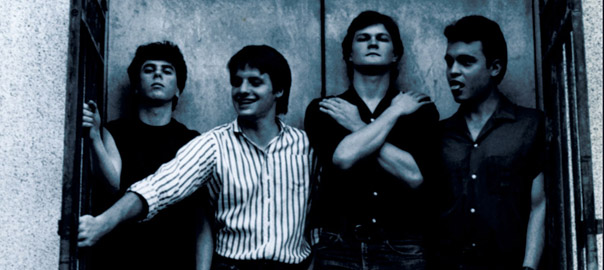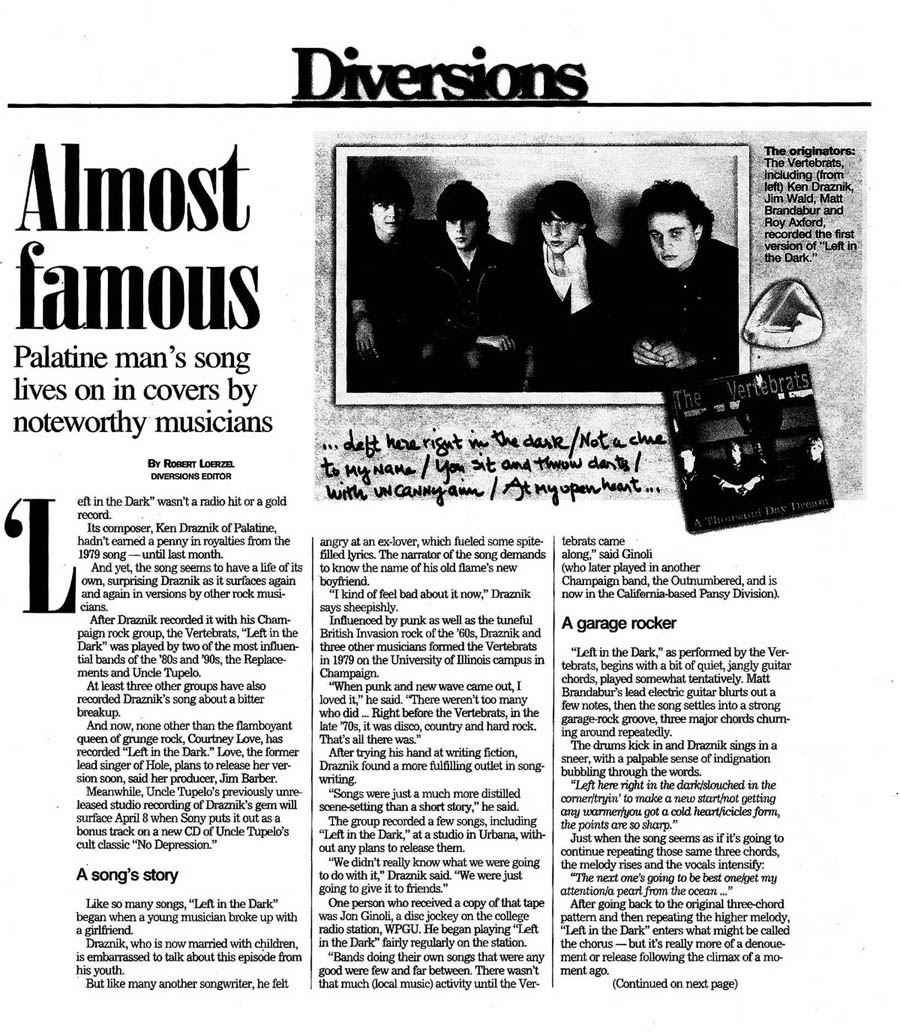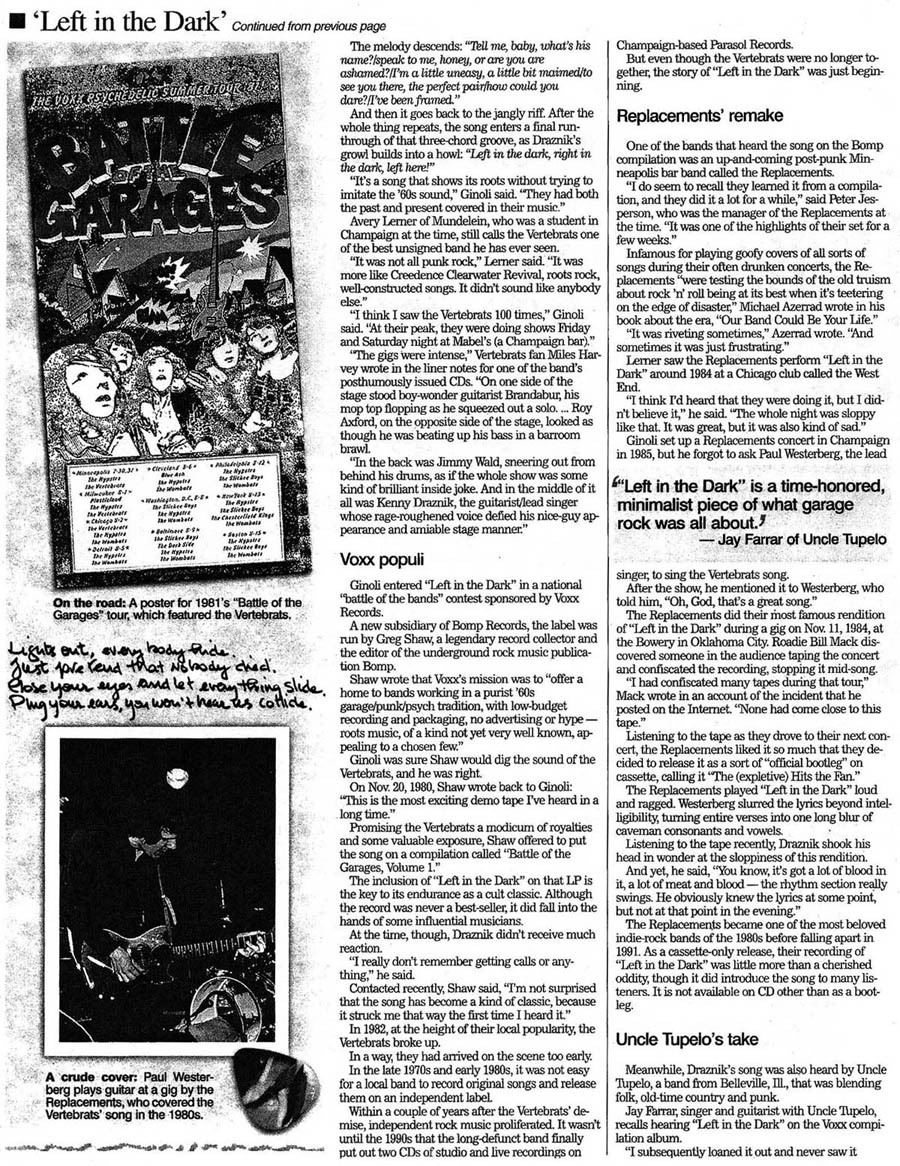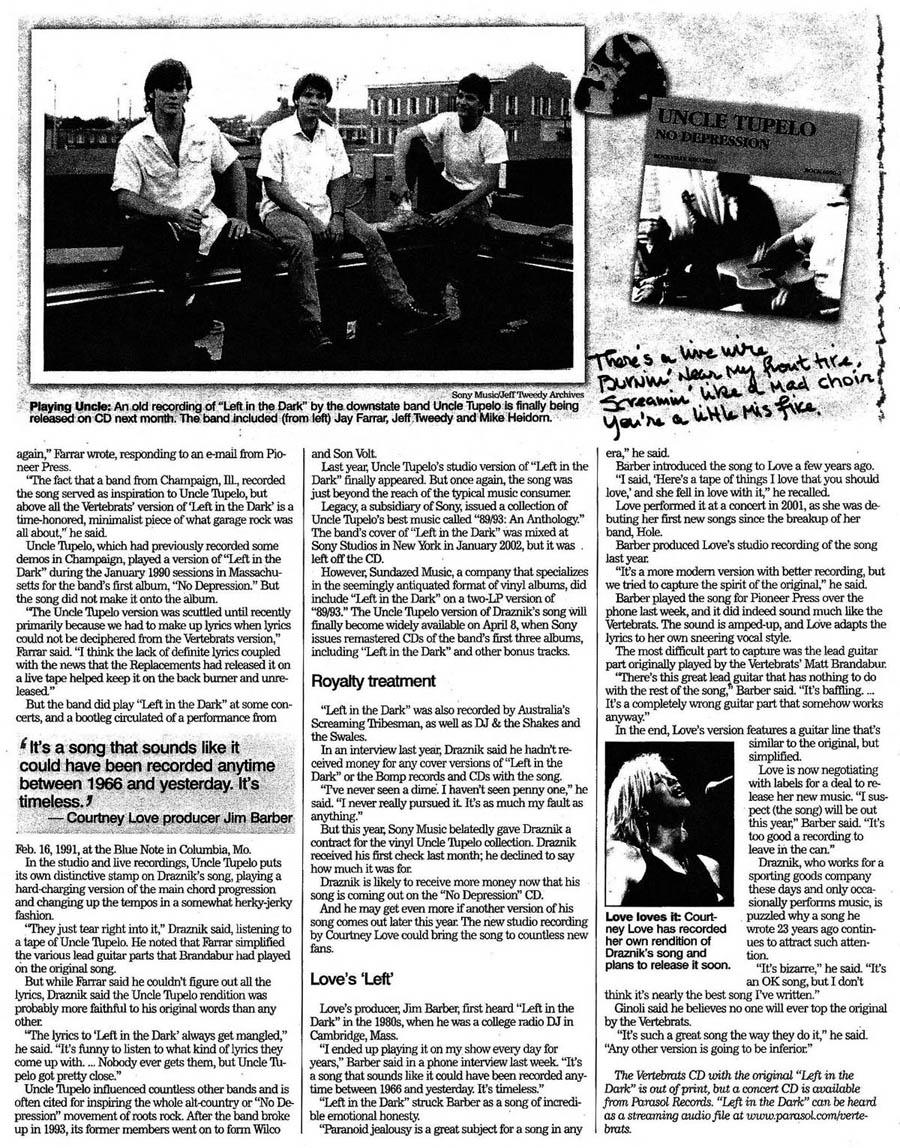This article by Robert Loerzel originally appeared in Pioneer Press on March 6, 2003. Winner of the Chicago Headline Club’s Peter Lisagor Award.
“Left in the Dark” wasn’t a radio hit or a gold record.
Its composer, Ken Draznik of Palatine, hadn’t earned a penny in royalties from the 1979 song — until last month.
And yet, the song seems to have a life of its own, surprising Draznik as it surfaces again and again in versions by other rock musicians.
After Draznik recorded it with his Champaign rock group, the Vertebrats, “Left in the Dark” was played by two of the most influential bands of the ’80s and ’90s, the Replacements and Uncle Tupelo.
At least three other groups have also recorded Draznik’s song about a bitter breakup.
And now, none other than the flamboyant queen of grunge rock, Courtney Love, has recorded “Left in the Dark.” Love, the former lead singer of Hole, plans to release her version soon, said her producer, Jim Barber.
Meanwhile, Uncle Tupelo’s previously unreleased studio recording of Draznik’s gem will surface April 8 when Sony puts it out as a bonus track on a new CD of Uncle Tupelo’s cult classic “No Depression.”
A song’s story
Like so many songs, “Left in the Dark” began when a young musician broke up with a girlfriend.
Draznik, who is now married with children, is embarrassed to talk about this episode from his youth.
But like many another songwriter, he felt angry at an ex-lover, which fueled some spite-filled lyrics. The narrator of the song demands to know the name of his old flame’s new boyfriend.
“I kind of feel bad about it now,” Draznik says sheepishly.
Influenced by punk, as well as the tuneful British Invasion rock of the ’60s, Draznik and three other musicians formed the Vertebrats in 1979 on the University of Illinois campus in Champaign.
“When punk and new wave came out, I loved it,” he said. “There weren’t too many who did. … Right before the Vertebrats, in the late ’70s, it was disco, country and hard rock. That’s all there was.”
After trying his hand at writing fiction, Draznik found a more fulfilling outlet in songwriting.
“Songs were just a much more distilled scene-setting than a short story,” he said.
The group recorded a few songs, including “Left in the Dark,” at a studio in Urbana, without any plans to release them.
“We didn’t really know what we were going to do with it,” Draznik said. “We were just going to give it to friends.”
One person who received a copy of that tape was Jon Ginoli, a disc jockey on the college radio station, WPGU. He began playing “Left in the Dark” fairly regularly on the station.
“Bands doing their own songs that were any good were few and far between. There wasn’t that much (local music) activity until the Vertebrats came along,” said Ginoli (who later played in another Champaign band, the Outnumbered, and is now in the California-based Pansy Division).
A garage rocker
“Left in the Dark,” as performed by the Vertebrats, begins with a bit of quiet, jangly guitar chords, played somewhat tentatively. Matt Brandabur’s lead electric guitar blurts out a few notes, then the song settles into a strong garage-rock groove, three major chords churning around repeatedly.
The drums kick in and Draznik sings in a sneer, with a palpable sense of indignation bubbling through the words.
“Left here right in the dark/slouched in the corner/tryin’ to make a new start/not getting any warmer/you got a cold heard/icicles form, the points are so sharp.”
Just when the song seems as if it’s going to continue repeating those same three chords, the melody rises and the vocals intensify:
“The next one’s going to be best one/get my attention/a pearl from the ocean…”
After going back to the original three-chord pattern and then repeating the higher melody, “Left in the Dark” enters what might be called the chorus — but it’s really more of a denouement or release following the climax of a moment ago.
The melody descends: “Tell me, baby, what’s his name?/speak to me, honey, or are you are ashamed?/I’m a little uneasy, a little bit maimed/to see you there, the perfect pair/how could you dare?/I’ve been framed.”
And then it goes back to the jangly riff. After the whole thing repeats, the song enters a final run-through of that three-chord groove, as Draznik’s growl builds into a howl: “Left in the dark, right in the dark, left here!”
“It’s a song that shows its roots without trying to imitate the ’60s sound,” Ginoli said. “They had both the past and present covered in their music.”
Avery Lerner of Mundelein, who was a student in Champaign at the time, still calls the Vertebrats one of the best unsigned bands he has ever seen.
“It was not all punk rock,” Lerner said. “It was more like Creedence Clearwater Revival, roots rock, well-constructed songs. It didn’t sound like anybody else.”
“I think I saw the Vertebrats 100 times,” Ginoli said. “At their peak, they were doing shows Friday and Saturday night at Mabel’s (a Champaign bar).”
“The gigs were intense,” Vertebrats fan Miles Harvey wrote in the liner notes for one of the band’s posthumously issued CDs. “On one side of the stage stood boy-wonder guitarist Brandabur, his mop top flopping as he squeezed out a solo. … Roy Axford, on the opposite side of the stage, looked as though he was beating up his bass in a barroom brawl.
“In the back was Jimmy Wald, sneering out from behind his drums, as if the whole show was some kind of brilliant inside joke. And in the middle of it all was Kenny Draznik, the guitarist/lead singer whose rage-roughened voice defied his nice-guy appearance and amiable stage manner.”
Voxx populi
Ginoli entered “Left in the Dark” in a national “battle of the bands” contest sponsored by Voxx Records.
A new subsidiary of Bomp Records, the label was run by Greg Shaw, a legendary record collector and the editor of the underground rock music publication Bomp.
Shaw wrote that Voxx’s mission was to “offer a home to bands working in a purist ’60s garage/punk/psych tradition, with low-budget recording and packaging, no advertising or hype — roots music, of a kind not yet very well known, appealing to a chosen few.”
Ginoli was sure Shaw would dig the sound of the Vertebrats, and he was right.
On Nov. 20, 1980, Shaw wrote back to Ginoli: “This is the most exciting demo tape I’ve heard in a long time.”
Promising the Vertebrats a modicum of royalties and some valuable exposure, Shaw offered to put the song on a compilation called “Battle of the Garages, Volume 1.”
The inclusion of “Left in the Dark” on that LP is the key to its endurance as a cult classic. Although the record was never a best-seller, it did fall into the hands of some influential musicians.
At the time, though, Draznik didn’t receive much reaction.
“I really don’t remember getting calls or anything,” he said
Contacted recently, Shaw said, “I’m not surprised that the song has become a kind of classic, because it struck me that way the first time I heard it.”
In 1982, at the height of their local popularity, the Verrtebrats broke up.
In a way, they had arrived on the scene too early. In the late 1970s and early 1980s, it was not easy for a local band to record original songs and release them on an independent label.
Within a couple of years after the Vertebrats’ demise, independent rock music proliferated. It wasn’t until the 1900s that the long-defunct band finally put out two CDs of studio and live recordings on Champaign-based Parasol Records.
But even though the Vertebrats were no longer together, the story of “Left in the Dark” was just beginning.
Replacements’ remake
One of the bands that heard the song on the Bomp compilation was an up-and-coming post-punk Minneapolis bar band called the Replacements.
“I do seem to recall they learned it from a compilation, and they did it a lot for a while,” said Peter Jesperson, who was the manager of the Replacements at the time. “It was one of the highlights of their set for a few weeks.”
Infamous for playing goofy covers of all sorts of songs during their often drunken concerts, the Replacements “were testing the bounds of the old truism about rock ’n’ roll being at its best when it’s teetering on the edge of disaster,” Michael Azerrad wrote in his book about the era, “Our Band Could Be Your Life.”
“It was riveting sometimes,” Azerrad wrote. “And sometimes it was just frustrating.”
Lerner saw the Replacements perform “Left in the Dark” around 1984 at a Chicago club called the West End.
“I think I’d heard that they were doing it, but I didn’t believe it,” he said. “The whole night was sloppy like that. It was great, but it was also kind of sad.”
Ginoli set up a Replacements concert in Champaign in 1985, but he forgot to ask Paul Westerberg, the lead singer, to sing the Vertebrats song.
After the show, he mentioned it to Westerberg, who told him, “Oh, God, that’s a great song.”
The Replacements did their most famous rendition of “Left in the Dark” during a gig on Nov. 11, 1984, at the Bowery in Oklahoma City. Roadie Bill Mack discovered someone in the audience taping the concert and confiscated the recording, stopping it mid-song.
“I had confiscated many tapes during that tour,” Mack wrote in an account of the incident that he posted on the Internet. “None had come close to this tape.”
Listening to the tape as they drove to their next concert, the Replacements liked it so much that they decided to release it as a sort of “official bootleg” on cassette, calling it “The (expletive) Hits the Fans.”
The Replacements played “Left in the Dark” loud and ragged. Westerberg slurred the lyrics beyond intelligibility, turning entire verses into one long blur of caveman consonants and vowels.
Listening to the tape recently, Draznik shook his head in wonder at the sloppiness of this rendition.
And yet, he said, “You know, it’s got a lot of blood in it, a lot of meat and blood — the rhythm section really swings. He obviously knew the lyrics at some point, but not at that point in the evening.”
The Replacements became one of the most beloved indie-rock bands of the 1980s before falling apart in 1991. As a cassette-only release, their recording of “Left in the Dark” was little more than a cherished oddity, though it did introduce the song to many listeners. It is not available on CD other than as a bootleg.
Uncle Tupelo’s take
Meanwhile, Draznik’s song was also heard by Uncle Tupelo, a band from Belleville, Ill., that was blending folk, old-time country and punk.
Jay Farrar, singer and guitarist with Uncle Tupelo, recalls hearing “Left in the Dark” on the Voxx compilation album.
“I subsequently loaned it out and never saw it again,” Farrar wrote, responding to an e-mail from Pioneer Press.
“The fact that a band from Champaign, Ill., recorded the song served as inspiration to Uncle Tupelo, but above all the Vertebrats’ version of ‘Left in the Dark’ is a time-honored, minimalist piece of what garage rock was all about,” he said.
Uncle Tupelo, which had previously recorded some demos in Champaign, played a version of “Left in the Dark” during the January 1990 sessions in Massachusetts for the band’s first album, “No Depression.” But the song did not make it onto the album.
‘The Uncle Tupelo version was scuttled until recently primarily because we had to make up lyrics when lyrics could not be deciphered from the Vertebrats version,” Farrar said. “I think the lack of definite lyrics coupled with the news that the Replacements had released it on a live tape helped keep it on the back burner and unreleased.”
But the band did play “Left in the Dark” at some concerts, and a bootleg circulated of a performance from Feb. 16, 1991, at the Blue Note in Columbia, Mo.
In the studio and live recordings, Uncle Tupelo puts its own distinctive stamp on Draznik’s song, playing a hard-charging version of the main chord progression and changing up the tempos in a somewhat herky-jerky fashion.
“They just tear right into it,” Draznik said, listening to a tape of Uncle Tupelo. He noted that Farrar simplified the various lead guitar parts that Brandabur had played on the original song.
But while Farrar said he couldn’t figure out all the lyrics, Draznik said the Uncle Tupelo rendition was probably more faithful to his original words than any other.
“The lyrics to ‘Left in the Dark’ always get mangled,” he said. “It’s funny to listen to what kind of lyrics they come up with. … Nobody ever gets them, but Uncle Tupelo got pretty close.”
Uncle Tupelo influenced countless other bands and is often cited for inspiring the whole alt-country or “No Depression” movement of roots rock. After the band broke up in 1993, its former members went on to form Wilco and Son Volt.
Last year, Uncle Tupelo’s studio version of “Left in the Dark” finally appeared. But once again, the song was just beyond the reach of the typical music consumer.
Legacy, a subsidiary of Sony, issued a collection of Uncle Tupelo’s best music called “89/93: An Anthology.” The band’s cover of “Left in the Dark” was mixed at Sony Studios in New York in January 2002, but it was left off the CD.
However, Sundazed Music, a company that specializes in the seemingly antiquated format of vinyl albums, did include “Left in the Dark” on a two-LP version of “89/93.” The Uncle Tupelo version of Draznik’s song will finally become widely available on April 8, when Sony issues remastered CDs of the band’s first three albums, including “Left in the Dark” and other bonus tracks.
Royalty treatment
“Left in the Dark” was also recorded by Australia’s Screaming Tribesman, as well as DJ & the Shakes and the Swales.
In an interview last year, Draznik said he hadn’t received money for any cover versions of “Left in the Dark” or the Bomp records and CDs with the song.
“I’ve never seen a dime. I haven’t seen penny one,” he said. “I never really pursued it. It’s as much my fault as anything.”
But this year, Sony Music belatedly gave Draznik a contract for the vinyl Uncle Tupelo collection. Draznik received his first check last month; he declined to say how much it was for.
Draznik is likely to receive more money now that his song is coming out on the “No Depression” CD.
And he may get even more if another version of his song comes out later this year. The new studio recording by Courtney Love could bring the song to countless new fans.
Love’s ‘Left’
Love’s producer, Jim Barber, first heard “Left in the Dark” in the 1980s, when he was a college radio DJ in Cambridge, Mass.
“I ended up playing it on my show every day for years,” Barber said in a phone interview last week. “It’s a song that sounds like it could have been recorded anytime between 1966 and yesterday. It’s timeless.”
“Left in the Dark” struck Barber as a song of incredible emotional honesty.
“Paranoid jealousy is a great subject for a song in any era,” he said.
Barber introduced the song to Love a few years ago. “I said, ‘Here’s a tape of things I love that you should love,’ and she fell in love with it,” he recalled.
Love performed it at a concert in 2001, as she was debuting her first new songs since the breakup of her band, Hole.
Barber produced Love’s studio recording of the song last year.
“It’s a more modern version with better recording, but we tried to capture the spirit of the original,” he said.
Barber played the song for Pioneer Press over the phone last week, and it did indeed sound much like the Vertebrats. The sound is amped-up, and Love adapts the lyrics to her own sneering vocal style.
The most difficult part to capture was the lead guitar part originally played by the Vertebrats’ Matt Brandabur.
“There’s this great lead guitar that has nothing to do with the rest of the song,” Barber said. ‘‘It’s baffling. … It’s a completely wrong guitar part that somehow works anyway.”
In the end, Love’s version features a guitar line that’s similar to the original, but simplified.
Love is now negotiating with labels for a deal to release her new music. “I suspect (the song) will be out this year,” Barber said. “It’s too good a recording to leave in the can.”
Draznik, who works for a sporting goods company these days and only occasionally performs music, is puzzled why a song he wrote 23 years ago continues to attract such attention.
“It’s bizarre,” he said. “It’s an OK song, but I don’t think it’s nearly the best song I’ve written.”
Ginoli said he believes no one will ever top the original by the Vertebrats.
“It’s such a great song the way they do it,” he said “Any other version is going to be inferior.”
Postscript: Courtney Love did not release her version of “Left in the Dark,” although bootlegs of it surfaced. In the meantime, even more bands have covered the song, as I reported later in a story for WBEZ Chicago Public Radio.



